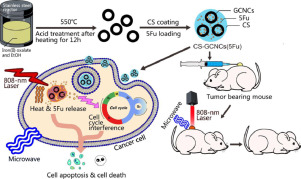当前位置:
X-MOL 学术
›
Acta Biomater.
›
论文详情
Our official English website, www.x-mol.net, welcomes your
feedback! (Note: you will need to create a separate account there.)
Biocompatible chitosan-carbon nanocage hybrids for sustained drug release and highly efficient laser and microwave co-irradiation induced cancer therapy.
Acta Biomaterialia ( IF 9.4 ) Pub Date : 2019-12-13 , DOI: 10.1016/j.actbio.2019.12.010 Yuliang Guo 1 , Yang Chen 2 , Pomchol Han 1 , Yuxiong Liu 1 , Wenhao Li 1 , Fangliang Zhu 1 , Kai Fu 1 , Maoquan Chu 1
Acta Biomaterialia ( IF 9.4 ) Pub Date : 2019-12-13 , DOI: 10.1016/j.actbio.2019.12.010 Yuliang Guo 1 , Yang Chen 2 , Pomchol Han 1 , Yuxiong Liu 1 , Wenhao Li 1 , Fangliang Zhu 1 , Kai Fu 1 , Maoquan Chu 1
Affiliation

|
Graphitic carbon nanocages (GCNCs) are unique graphene-based nanomaterials that can be used for cancer photothermal therapy (PTT). However, low toxicity GCNC-based organic/inorganic hybrid biomaterials for microwave irradiation assisted PTT have not yet been reported. In the present study, chitosan (CS)-coated GCNCs (CS-GCNCs) loaded with 5-fluorouracil (5Fu) were used for cancer therapy when activated by 808-nm laser and microwave co-irradiation. The cytotoxicity of GCNCs was significantly reduced after coating with CS. For example, fewer cell-cycle defects were caused by CS-GCNCs in comparison with non-coated GCNCs. The release rate of 5Fu from CS-GCNCs was significantly slower than that of 5Fu from GCNCs, providing sustained release. The release rate could be accelerated by 808-nm laser and microwave co-irradiation. The 5Fu in CS-GCNCs retained high cancer cell killing bioactivity by enhancing the caspase-3 expression level. The cancer cell killing and tumor inhibition efficiencies of the 5Fu-loaded nanomaterials increased significantly under 808-nm laser and microwave co-irradiation. The strong cell killing and tumor ablation activities were due to the synergy of the enhanced GCNC thermal effect caused by laser and microwave co-irradiation and the chemotherapy of 5Fu. Our research opens a door for the development of drug-loaded GCNC-based nano-biomaterials for chemo-photothermal synergistic therapy with the assistance of microwave irradiation. STATEMENT OF SIGNIFICANCE: Graphitic carbon nanocages (GCNCs) are graphene-based nanomaterials that can be used for both drug loading and cancer photothermal therapy (PTT). Herein, we showed that chitosan (CS)-GCNCs hybrid biomaterials had very low cytotoxicity, high ability for loading drug, and exhibited sustained drug release. In particular, although low-power microwaves alone are unable to trigger cancer cell damage by GCNCs, the cell killing and mouse tumor inhibition efficiencies were significantly improved by near-infrared (NIR) laser and microwave co-irradiation compared with laser-triggered PTT alone. This combined use of laser and microwave co-irradiation promises essential therapeutic modality and opens a new avenue for PTT.
中文翻译:

具有生物相容性的壳聚糖-碳纳米笼杂合物,用于持续释放药物以及高效的激光和微波共同照射诱导的癌症治疗。
石墨碳纳米笼(GCNC)是基于石墨烯的独特纳米材料,可用于癌症光热疗法(PTT)。然而,尚未报道用于微波辐射辅助的PTT的低毒性基于GCNC的有机/无机杂化生物材料。在本研究中,当通过808 nm激光和微波共辐照激活时,负载有5-氟尿嘧啶(5Fu)的壳聚糖(CS)涂层GCNC(CS-GCNC)被用于癌症治疗。用CS包被后,GCNC的细胞毒性显着降低。例如,与未涂覆的GCNC相比,CS-GCNC引起的细胞周期缺陷更少。CS-GCNCs中5Fu的释放速率显着低于GCNCs中5Fu的释放速率,从而提供了持续释放。808 nm激光和微波共同辐照可以加快释放速度。CS-GCNCs中的5Fu通过增强caspase-3表达水平而保留了杀死癌细胞的高生物活性。在808 nm激光和微波共同照射下,负载5Fu的纳米材料的癌细胞杀伤和肿瘤抑制效率显着提高。强大的细胞杀伤和肿瘤消融活性是由于激光和微波共辐照和5Fu化疗引起的增强GCNC热效应的协同作用所致。我们的研究为利用载药的基于GCNC的纳米生物材料的开发打开了大门,该材料在微波辐射的辅助下可用于化学光热协同治疗。意义声明:石墨碳纳米笼(GCNC)是基于石墨烯的纳米材料,可用于载药和癌症光热疗法(PTT)。在此处,我们表明,壳聚糖(CS)-GCNCs杂化生物材料具有极低的细胞毒性,高载药能力,并表现出持续的药物释放。特别是,尽管仅靠低功率微波无法引发GCNC损伤癌细胞,但与单独使用激光触发的PTT相比,近红外(NIR)激光和微波共辐照可显着提高细胞杀伤和小鼠肿瘤抑制效率。激光和微波共辐射的这种结合使用有望实现基本的治疗方式,并为PTT开辟了一条新途径。与单独使用激光触发的PTT相比,近红外(NIR)激光和微波共辐照可显着提高细胞杀伤和小鼠肿瘤抑制效率。激光和微波共辐射的这种结合使用有望实现基本的治疗方式,并为PTT开辟了一条新途径。与单独使用激光触发的PTT相比,近红外(NIR)激光和微波共辐照可显着提高细胞杀伤和小鼠肿瘤抑制效率。激光和微波共辐射的这种结合使用有望实现基本的治疗方式,并为PTT开辟了一条新途径。
更新日期:2019-12-13
中文翻译:

具有生物相容性的壳聚糖-碳纳米笼杂合物,用于持续释放药物以及高效的激光和微波共同照射诱导的癌症治疗。
石墨碳纳米笼(GCNC)是基于石墨烯的独特纳米材料,可用于癌症光热疗法(PTT)。然而,尚未报道用于微波辐射辅助的PTT的低毒性基于GCNC的有机/无机杂化生物材料。在本研究中,当通过808 nm激光和微波共辐照激活时,负载有5-氟尿嘧啶(5Fu)的壳聚糖(CS)涂层GCNC(CS-GCNC)被用于癌症治疗。用CS包被后,GCNC的细胞毒性显着降低。例如,与未涂覆的GCNC相比,CS-GCNC引起的细胞周期缺陷更少。CS-GCNCs中5Fu的释放速率显着低于GCNCs中5Fu的释放速率,从而提供了持续释放。808 nm激光和微波共同辐照可以加快释放速度。CS-GCNCs中的5Fu通过增强caspase-3表达水平而保留了杀死癌细胞的高生物活性。在808 nm激光和微波共同照射下,负载5Fu的纳米材料的癌细胞杀伤和肿瘤抑制效率显着提高。强大的细胞杀伤和肿瘤消融活性是由于激光和微波共辐照和5Fu化疗引起的增强GCNC热效应的协同作用所致。我们的研究为利用载药的基于GCNC的纳米生物材料的开发打开了大门,该材料在微波辐射的辅助下可用于化学光热协同治疗。意义声明:石墨碳纳米笼(GCNC)是基于石墨烯的纳米材料,可用于载药和癌症光热疗法(PTT)。在此处,我们表明,壳聚糖(CS)-GCNCs杂化生物材料具有极低的细胞毒性,高载药能力,并表现出持续的药物释放。特别是,尽管仅靠低功率微波无法引发GCNC损伤癌细胞,但与单独使用激光触发的PTT相比,近红外(NIR)激光和微波共辐照可显着提高细胞杀伤和小鼠肿瘤抑制效率。激光和微波共辐射的这种结合使用有望实现基本的治疗方式,并为PTT开辟了一条新途径。与单独使用激光触发的PTT相比,近红外(NIR)激光和微波共辐照可显着提高细胞杀伤和小鼠肿瘤抑制效率。激光和微波共辐射的这种结合使用有望实现基本的治疗方式,并为PTT开辟了一条新途径。与单独使用激光触发的PTT相比,近红外(NIR)激光和微波共辐照可显着提高细胞杀伤和小鼠肿瘤抑制效率。激光和微波共辐射的这种结合使用有望实现基本的治疗方式,并为PTT开辟了一条新途径。









































 京公网安备 11010802027423号
京公网安备 11010802027423号